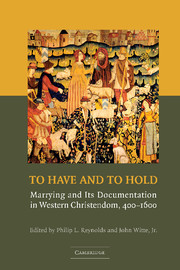Book contents
- Frontmatter
- Contents
- List of Contributors
- Preface and Acknowledgments
- List of Abbreviations
- 1 Marrying and Its Documentation in Pre-Modern Europe: Consent, Celebration, and Property
- 2 Marrying and Its Documentation in Later Roman Law
- 3 Marrying and the Tabulae Nuptiales in Roman North Africa from Tertullian to Augustine
- 4 Dotal Charters in the Frankish Tradition
- 5 Marriage and Diplomatics: Five Dower Charters from the Regions of Laon and Soissons, 1163–1181
- 6 Marriage Agreements from Twelfth-Century Southern France
- 7 Marriage Contracts in Medieval England
- 8 Marriage Contracts and the Church Courts of Fourteenth-Century England
- 9 Marrying and Marriage Litigation in Medieval Ireland
- 10 Marriage Contracts in Medieval Iceland
- 11 Contracting Marriage in Renaissance Florence
- 12 Marital Property Law as Socio-Cultural Text: The Case of Late-Medieval Douai
- 13 Marriage Contracts, Liturgies, and Properties in Reformation Geneva
- Index
9 - Marrying and Marriage Litigation in Medieval Ireland
Published online by Cambridge University Press: 12 September 2009
- Frontmatter
- Contents
- List of Contributors
- Preface and Acknowledgments
- List of Abbreviations
- 1 Marrying and Its Documentation in Pre-Modern Europe: Consent, Celebration, and Property
- 2 Marrying and Its Documentation in Later Roman Law
- 3 Marrying and the Tabulae Nuptiales in Roman North Africa from Tertullian to Augustine
- 4 Dotal Charters in the Frankish Tradition
- 5 Marriage and Diplomatics: Five Dower Charters from the Regions of Laon and Soissons, 1163–1181
- 6 Marriage Agreements from Twelfth-Century Southern France
- 7 Marriage Contracts in Medieval England
- 8 Marriage Contracts and the Church Courts of Fourteenth-Century England
- 9 Marrying and Marriage Litigation in Medieval Ireland
- 10 Marriage Contracts in Medieval Iceland
- 11 Contracting Marriage in Renaissance Florence
- 12 Marital Property Law as Socio-Cultural Text: The Case of Late-Medieval Douai
- 13 Marriage Contracts, Liturgies, and Properties in Reformation Geneva
- Index
Summary
Medieval Ireland, according to contemporaries, was a country divided into two “nations.” On the one hand there were the descendants of the Anglo-Norman settlers of the late twelfth and early thirteenth century; on the other, the successors to the older Gaelic Irish population. The church could not avoid being affected by this division and itself became split into two sections, one inter Anglicos (among the Anglo-Irish), the other inter Hibernicos (among the Gaelic Irish). We must therefore investigate marital behavior in the two parts of Ireland: the section of the country under English control and using English law, Anglo-Ireland; and the Gaelic Irish area where a different legal system, the old brehon law, still held sway. But first, a word about the context in canon law.
Church law on marriage was defined and clarified during the twelfth and early thirteenth centuries. Basic Christian teaching was straightforward: What God has united, man must not divide (Mark 10:10). But how do you know when God has united a man and a woman in matrimony? In other words, what constitutes a marriage? The attempts by theologians and canonists to formulate an answer to this question resulted in a definition of marriage that changed little between the thirteenth and sixteenth centuries.
The matrimonial bond was created by the consent of the two parties, freely given.
- Type
- Chapter
- Information
- To Have and to HoldMarrying and its Documentation in Western Christendom, 400–1600, pp. 332 - 359Publisher: Cambridge University PressPrint publication year: 2007



